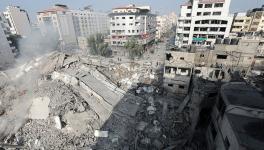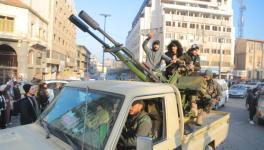Moscow Prioritises Ties With Myanmar
Russian Foreign Minister Sergey Lavrov (L) met Chairman of State Administrative Council & Prime Minister of Myanmar’s Provisional Government, Min Aung Hlaing, Naypyidaw, August 3, 2022
The Russian Foreign Minister Sergey Lavrov’s visit to Myanmar on August 3 shows that the relationship is assuming a strategic character. The Foreign Ministry in a press release on August 2, highlighted that the relationship is “one of the priorities of foreign policy in the Asia-Pacific region, an important factor in ensuring peace, stability and sustainable development.”
The foreign ministry noted that “Myanmar partners at the official levels express their understanding of the reasons and validity of Russia’s actions in the framework of a special military operation in Ukraine. Naypyidaw does not recognise the legitimacy of Western anti-Russian sanctions.
“At the UN and other multilateral platforms, Russia is pursuing a line to ensure a balanced and non-politicised discussion of the situation in Myanmar in connection with the state of emergency in force in this country since February 2021, and advocates the search for constructive forms of international assistance to this country without interference in its internal affairs. We assist Naypyidaw in rapprochement with integration associations and mechanisms of multilateral cooperation in Eurasia, including the EAEU and the SCO.”
Indeed, Lavrov scheduled his talks in Myanmar before the ASEAN-Russia foreign ministers meet in Phnom Penh. The press release issued on August 3 after Lavrov’s talks with the Chairman of the State Administrative Council, Prime Minister of the Provisional Government, Min Aung Hlaing said they held “an in-depth discussion of the geopolitical situation that is emerging against the background of the unprecedented sanctions campaign unleashed by the collective West both against Russia and against Myanmar. He (Min Aung Hlaing) confirmed the need for coordinated steps to strengthen a multipolar world order…”
Myanmar becomes the second country after Iran in the Indian Ocean region that has voiced unequivocal support for Russia. Conceivably, Lavrov may now have to visit Colombo too, once the new government is formed.
Russia & Sri Lanka’s colour revolution
It is difficult to assess whether the mayhem in Sri Lanka on July 9 had anything to do with the impending visit of a Sri Lankan government delegation’s weeklong trip to Moscow the next day (scheduled for July 10-16) to hold crucial talks with various Russian economic ministries on July 10-16 regarding Russia’s help to tide over the crisis. But it remains a reasonable assumption.
The Russian Foreign Ministry spokesperson’s remarks on July 11, regarding the Sri Lankan situation pointedly mentioned, “Notably, the day before the unrest began, some Western diplomatic mission heads openly urged the local police not to obstruct “peaceful protests.” It added,
“We believe that the developments in Sri Lanka are its internal affair and the political process in that country, which we regard as friendly, will develop further in keeping with its constitution and effective laws. We expect a new government to be formed and are ready to cooperate with it. We believe the situation will return to normal before long and that the new Sri Lankan authorities will take the necessary measures to ride out the crisis in the national economy.”
Indeed, Ranil Wickremesinghe, then prime minister, also told Tass in an exclusive interview about the unprecedented nature of the political turmoil — that “the island nation’s politicians cannot yet find parallels to a similar crisis in this century or in the last century or the century before.”
It appears that Moscow anticipated that the US-backed unrest in Sri Lanka would fail to produce a regime change that the “Collective West” wanted. Interestingly, President Vladimir Putin in his congratulatory message to Wickremesinghe on his election as president noted, “I am counting on your activities as Head of State to foster further development of constructive bilateral cooperation in various spheres for the benefit of our peoples and in the interest of strengthening regional stability and security.”
A glance at the map of Indian Ocean would show why relations with Iran, Myanmar and Sri Lanka have become so consequential for Russia. The ports in Myanmar, Sri Lanka and Myanmar are vital to sustaining an effective Russian naval presence in the region. The strategic compulsions are amplified in Russia’s revised Naval Doctrine, which Putin decreed on July 30, reflecting the “change in the geopolitical and military-strategic situation in the world.”
Russia & world’s oceans
The 56-page document (in Russian) explicitly states that Russia’s national interests “as a great naval power extend to the entire world’s oceans and the Caspian Sea”. It acknowledges the lack of overseas naval re-supply points and bases, which are crucial for expanding the operational range of the Russian Navy, while spotlighting that “the strategic course of the US to dominate in the world oceans” poses “challenges and threats.”
However, the doctrine envisions the creation of such a facility in the Red Sea. Besides, it also includes plans to construct a new shipbuilding facility in Russia’s Far East to build “large-capacity vessels” including ships suitable “for the development of the Arctic,” as well as “modern aircraft carriers for the Navy.” Currently, Russia has only one aircraft-carrying naval vessel, the Admiral Kuznetsov cruiser, which has been out of commission and undergoing repairs.
Meanwhile, the US has been steadily strengthening a maritime cooperation grid with Indian Ocean states. Recently, Washington unveiled a West Asian Quad under the ingenious rubric I2U2 (Israel-India, US-UAE). President Biden took its first summit meeting. (here and here)
Delhi insists that I2U2 is a platform for regional economic partnerships but western strategists candidly discuss the geopolitics looming behind economics. Michel Gurfinkiel at the Middle East Forum wrote in Wall Street Journal, “Jake Sullivan, Mr. Biden’s national security adviser, compared I2U2 to the Quadrilateral Security Dialogue, the embryonic Indo-Pacific alliance of the US, Japan, Australia and India… US, Indian and Emirati media all see it as an extension of the 2019 Abraham Accords.”
Indeed, the longer view is even more pertinent because beyond I2U2, the Quad and the Abraham Accords, one considers many analogous developments in international security — Ukraine conflict, NATO expansion, Eastern Mediterranean security alliance (France, Italy, Greece, Cyprus, Israel and Egypt); Negev Summit architecture (Israel, Morocco, Egypt, UAE. and Bahrain); AUKUS (the born-again Anglo-Pacific defence community between Australia, US and UK); upgrade of US-Taiwan relationship; Japan’s militarisation (overcoming acrimonious history), etc.
Geopolitical cross-currents
In the above backdrop, India’s gravitation toward the US-led security alliance system is a contradiction. India’s strategic focus is China but the US’s includes Russia and Iran as well. India prioritises its strategic ties with Israel —the management of Haifa port (which the US Sixth Fleet frequents) has been awarded to an Indian company recently. Whereas, Israel’s and the US’ obsession is with Iran, which is friendly towards India.
On the other hand, Iran is strengthening its ties with Russia and China. Perhaps, UAE and India are playing both ends. But they are also regimes lacking strategic culture and prone to whimsicality attuned to Washington’s agenda.
Clearly, the confidence in the US’ reliability has been generally undermined in recent years in the swathe of land between the Levant and Malacca Straits. Biden’s recent initiative in Jeddah to promote a West Asian military alliance to counter Iran, Russia and China had no takers.
Russian diplomacy has to navigate between these shoals. The great game in the Indian Ocean region is wide open. Lavrov’s visit to Myanmar signals that Moscow will push back the US’ attempts to create “blocs” to dominate the Indian Ocean’s sea lanes. Access to the ports in Myanmar can be a game changer for Russian presence.
Interestingly, Min Aung Hlaing complained to Lavrov that Russian officials “rarely” visit Myanmar! Lavrov promised to make amends. Moscow intends to fulfil that promise, as Russia’s cooperation with Myanmar spreads wings — trade to investments in energy projects, nuclear cooperation, military-technical cooperation, space, education, etc.
Direct flights are being established. Mir payment cards are accepted in Myanmar, which is also keen on settlement in local currencies. Moscow plans to establish in Yangon a parish of the Patriarchal Exarchate of the Russian Orthodox Church in Southeast Asia — and a temple.
MK Bhadrakumar is a former diplomat. He was India’s ambassador to Uzbekistan and Turkey. The views are personal.
Get the latest reports & analysis with people's perspective on Protests, movements & deep analytical videos, discussions of the current affairs in your Telegram app. Subscribe to NewsClick's Telegram channel & get Real-Time updates on stories, as they get published on our website.
























